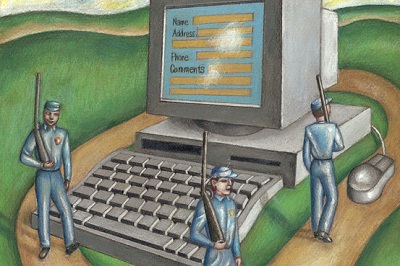News
Cyberspace Turns Full-Blown War Zone-FireEye

Cyberspace has become a full-blown war zone as governments across the globe clash for digital supremacy in a new, mostly invisible theater of operations, according to an executive summary of a report released by FireEye at the weekend.
The report made available to Nigeria CommunicationsWeek said that, once limited to opportunistic criminals, cyber attacks are becoming a key weapon for governments seeking to defend national sovereignty and project national power.
From strategic cyber espionage campaigns, such as Moonlight Maze and Titan Rain, to the destructive, such as military cyber strikes on Georgia and Iran, human and international conflicts are entering a new phase in their long histories.
In this shadowy battlefield, victories are fought with bits instead of bullets, malware instead of militias, and botnets instead of bombs, the report contained.
A word of warning from the cyber security power house reiterated that the analytical waters surrounding cyber warfare are inherently murky, as these covert assaults are largely unseen by the public.
“Unlike the wars of yesteryear, this cyber war produces no dramatic images of exploding warheads, crumbled buildings, or fleeing civilians. But the list of casualties—which already includes some of the biggest names in technology, financial services, defense, and government —is growing larger by the day”.
A cyber attack is best understood not as an end in itself, but as a potentially powerful means to a wide variety of political, military, and economic goals.
“Serious cyber attacks are unlikely to be motiveless,” said Martin Libicki, Senior Scientist at RAND Corp. “Countries carry them out to achieve certain ends, which tend to reflect their broader strategic goals. The relationship between the means chosen and their goals will look rational and reasonable to them if not necessarily to us.”
Just as each country has a unique political system, history, and culture, state-sponsored attacks also have distinctive characteristics, which include everything from motivation to target to type of attack.
This report describes the unique characteristics of cyber attack campaigns waged by governments worldwide. We hope that, armed with this knowledge, security professionals can better identify their attackers and tailor their defenses accordingly.
A quick overview of the report painted Asia-Pacific as home to large, bureaucratic hacker groups such as the “Comment Crew” who pursue many goals and targets in high-frequency, brute-force attacks, while Russia/Eastern Europe, these cyber attacks are more technically advanced and highly effective at evading detection.
In the Middle East, the hackers are dynamic, often using creativity, deception, and social engineering to trick users into compromising their own computers and in the United States are the most complex, targeted, and rigorously engineered cyber attack campaigns to date.
FireEye noted that at the strategic level, governments desire to have a degree of plausible deniability.
“At the tactical level, military and intelligence organizations envelop such operations in layers of classification and secrecy. To be effective, information operations rely on deception—and the Internet offers an ideal venue for a spy’s smoke and mirrors.
“In practical terms, hackers often run their attacks through cyber terrain (such as compromised, third-party networks) that present investigators with technical and jurisdictional complications. And finally, cybercriminal tools, tactics, and procedures (TTPs) evolve so quickly that cyber defense, legislation, and law enforcement remain behind the attacker’s curve.
“The biggest challenge to deterring, defending against, or retaliating for cyber attacks is the problem of correctly identifying the perpetrator,” said Prof. John Arquilla, Naval Postgraduate School in an email interview with FireEye.®
“Ballistic missiles come with return addresses. But computer viruses, worms, and denial of service attacks often emanate from behind a veil of anonymity. The best chance to pierce this veil comes with the skillful blending of forensic back-hacking techniques with deep knowledge of others’ strategic cultures and their geopolitical aims.”
Cyber “attribution”—identifying a likely culprit, whether an individual, organization, or nation-state—is notoriously difficult, especially for any single attack. States are often mistakenly identified as non-state actors, and vice versa.
To make matters worse, ties between the two are increasing. First, a growing number of “patriotic cybercriminals” ostensibly wage cyber war on behalf of governments (examples include Chechnya and Kosovo in the 1990s, China in 2001, Estonia in 2007, Georgia in 2008, and every year in the Middle East).
“Second, cybercrime organizations offer anyone, including governments, cyber attack services to include denial-of-service attacks and access to previously compromised networks. FireEye researchers have even seen one nation-state develop and use a sophisticated Trojan, and later (after its own counter-Trojan defenses were in place) sell it to cybercriminals on the black market.
“Thus, some cyber attack campaigns may bear the hallmarks of both state and non-state actors, making positive attribution almost impossible. And finally, “false flag” cyber operations involve a hacker group behaving like another to mislead cyber defense researchers,” the report contained.
News
NIA Questions Legality of Reps’ Financial Probe

The Nigerian Insurers Association has urged the House Committee on Capital Market and Institutions to respect the constitutional separation of powers as it carries out a probe on over 20 insurance firms.

In a statement on Tuesday night, the Director General/Chief Executive Officer of NIA, Mrs Bola Odukale, said the decision of NIA and the affected firms to approach the court was to seek clarity on the constitutional limits of the House Committee’s probe.
It would be recalled that the House of Representatives on Monday is investigating no fewer than 25 insurance companies operating in the country for various financial infractions spanning financial reporting, claims settlement, premium remittance, and issuance of policies.
The Chairman, House Sub-Committee on Capital Market and Institutions, Kwamoti Laori, during a meeting with the management of the insurance companies at the National Assembly Complex in Abuja, said the meeting was convened following the receipt of a petition on infractions by the insurance companies.
In the statement, Odukale said, “The Association wishes to state unequivocally that all actions taken by the NIA and the affected member companies in response to the Committee’s invitations and pronouncements were based entirely on legal advice by its Solicitors. It was on the firm instruction of legal counsel that recourse was made to the courts.
“The objective of approaching the Court is to seek judicial guidance on the legality, propriety, and constitutional limits of the Committee’s intervention in order to safeguard institutional integrity, uphold regulatory independence, and ensure that legislative oversight remains within the bounds of law.
“The Court action seeks to determine whether the current posture of the Committee reflects an exercise of legislative judgment, which, by constitutional design, is the exclusive province of statutory regulators, such as the National Insurance Commission, Securities and Exchange Commission, Nigerian Exchange, Financial Reporting Council, Nigeria Data Protection Commission, and the National Information Technology Development Agency.
“This raises serious questions about legislative overreach and an erosion of the doctrine of separation of powers, a cornerstone of Nigeria’s constitutional democracy.”
Odukale maintained that the NIA was committed to lawful and constructive engagement with all arms of government, provided that such engagement respects the autonomy of statutory regulators and the boundaries established by the Constitution.
“The NIA will continue to provide its full support to all member companies while upholding the principles of legal compliance and sector-wide integrity,” Odukale concluded.
17 of the companies that went to court were represented by their lawyer, Mr Abimbola Kayode, at the meeting with the committee.
News
Horn of Africa Leaders Seek Enhanced Digital Integration for Increased Regional Growth
Finance ministers and development partners from the Horn of Africa have called for enhanced digital integration to boost trade, drive economic growth and promote regional stability during the 25th Ministerial Meeting of the Horn of Africa Initiative (HoAI).
![]()
Held in Nairobi, on July 14, the meeting was co-chaired by the African Development Bank’s Vice President for Regional Development, Integration and Business Delivery, Nnenna Nwabufo and Somalia’s Minister of Finance, Bihi Iman Egeh. Discussions underscored the critical role of digital integration in reducing trade barriers, boosting government service delivery and creating employment — particularly for the region’s youth.
“Digital technologies are shaping today’s economy and tomorrow’s industries. By embedding these technologies into our programs, we can not only improve inclusion but also leapfrog outdated development models,” said Nwabufo.
She called for digital integration a “central enabler” in each of the Horn of Africa Initiative’s pillars – trade, infrastructure, resilience, and human capital,
Learning through experience
Drawing from global and regional success stories, speakers highlighted the transformative potential of technology-led development. The ministers pointed to the Philippines as a strong example, where ICT has generated millions of jobs in business process outsourcing. Similarly, Kenya’s fintech innovation—especially the success of M-PESA—was cited as a model for scaling digital financial services across the region.
Participants urged governments to proactively foster digital ecosystems by capitalizing on the demographic dividend, identifying infrastructure upgrades, tighter regulatory reforms, and digital skills trainings as priorities to enable broader participation in the digital economy.
Minister Egeh reiterated the need for more coordinated regional efforts to create the enabling environment required for accelerated digital integration and expansion. He referenced the HoAI Digital Policy Matrix, adopted in 2023 which provides a blueprint on how to address key obstacles to achieving effective digital integration across the region.
Barack Makokha, Kenya’s Cabinet Secretary for National Treasury, underscored the importance of regionally-aligned public private partnerships and advocated for blended financing to reduce investment risk and expand digital access in underserved areas.
World Bank Vice President for Eastern and Southern Africa, Ndiame Diop, called for a comprehensive multi-pronged approach, combining cross-border coordination, large-scale financing, robust policy support, and digital infrastructure investments. He pointed out that such measures could transform digital integration into, “a powerful engine of economic transformation” for the Horn of Africa—ensuring no one is left behind in the digital era.
The meeting concluded with a shared recognition that sustained political will and the determination to implement a multifaceted approach are essential to unlocking the region’s economic potential and driving long-term growth.
The event also welcomed observers from the East African Community, Agence française de développement, and Shelter Afrique, reflecting strong regional and international backing for the HoAI in the development community.
News
CSCS Inaugurates Custodian Portal to Enhance Digital Access, Operational Efficiency

Central Securities Clearing System Plc (CSCS), Nigeria’s capital market infrastructure provider, has launched its Custodian Portal, a user-centric digital solution designed to optimise custodian operations through intuitive, secure and efficient features.

Haruna Jalo-Waziri, Chief Executive Officer (CEO), CSCS, announced this in a statement on Monday.
The CSCS is a Public Limited Company with a diversified shareholder base, which serves as the Central Securities Depository for the Nigerian Capital Market.
It serves as the Central Depository for Equities, Commercial Papers, Corporate Bonds, Sub-National Bonds, certain Sovereign Bonds like the FGN Sukuk and the FGN Savings Bond, Equity-traded Funds, Real Estate Investment Trusts, Mutual funds and Commodities.
Jalo-Waziri said that the custodian portal offered a streamlined experience for market participants with powerful tools that facilitate comprehensive portfolio and trade management, document tracking, share transfer operations, client symbol search, and real-time access to vital data.
He explained that the portal, designed to operate through a flexible subscription-based model, empowered users to manage their records effortlessly and securely through convenient payment channels such as GTPay and Paystack.
According to him, “Digital transformation remains at the core of our strategy to enhance the efficiency, transparency and accessibility of Nigeria’s capital market services.
“The custodian portal is a significant leap in that direction, offering custodians a centralised platform to manage critical processes in real-time.
“We are excited about the value this innovation brings to our stakeholders, and we will continue to evolve the platform in line with users’ needs and industry trends.”
The CEO also explained that the portal was designed with user experience in mind with feature tools like portfolio viewing and downloads in PDF or Excel format.
He further said that it also featured tracking of stock movements across date ranges, inbox messaging and request tracking, as well as robust user management capabilities including role assignment and status tracking.
Similarly, the Divisional Head, Business Technology and Digital Innovation, CSCS Plc, Tobe Nnadozie, said that the portal aligned with CSCS’s drive to automate the market.
“In addition to the normal features, the platform is a part of an omnichannel platform for custodians, and includes API services.
“It also connects to the market-wide workflow, which CSCS has built to ensure secured communication and approvals across all major stakeholders in the market.
“The platform is well secured with best-of-breed cybersecurity solutions and our SOC,” he said.
The Custodian Portal reinforces CSCS’s commitment to leveraging technology to streamline back-office functions and support a more agile, data-driven capital market ecosystem.
All custodians in the Nigerian capital market have now been successfully on-boarded on the Custodian Portal, marking a significant milestone in CSCS’s ongoing drive to enhance collaboration, standardise operational processes, and promote digital adoption across the market.

 E-Financial3 days ago
E-Financial3 days agoKuda Unveils New Wallet for Multiple Currencies

 Telecom3 days ago
Telecom3 days agoTelcos Resume SIM Card Sales after 2-Week Halt

 Telecom3 days ago
Telecom3 days agoNigeria, Others Achieve 84% Adult Mobile Phones Penetration

 E-Business3 days ago
E-Business3 days agoHow AI Alert by Airtel is Transforming Mobile Security in Africa

 E-Business3 days ago
E-Business3 days agoNITDA, API Partner Against Harmful Online Content

 Telecom2 days ago
Telecom2 days agoGlo Launches Nigeria’s First-of-its-kind Device Protection Plan

 Telecom2 days ago
Telecom2 days agoTelcos: How and Why Network Services have Been Poor

 News3 days ago
News3 days agoHorn of Africa Leaders Seek Enhanced Digital Integration for Increased Regional Growth



























